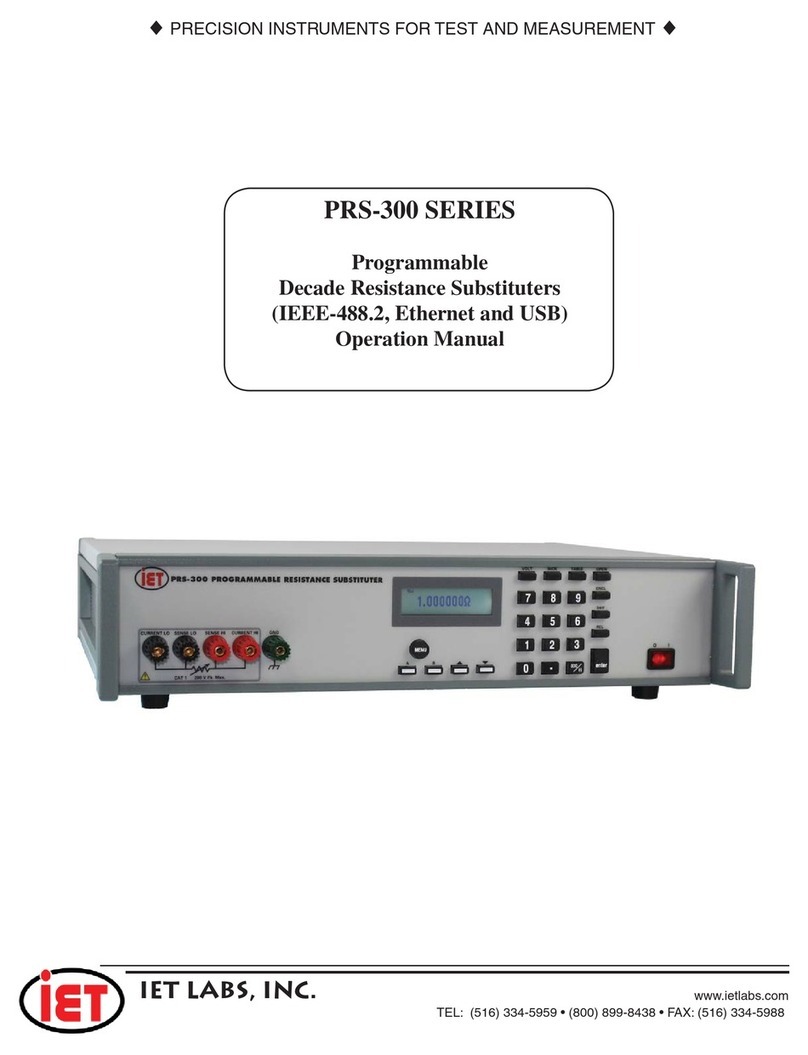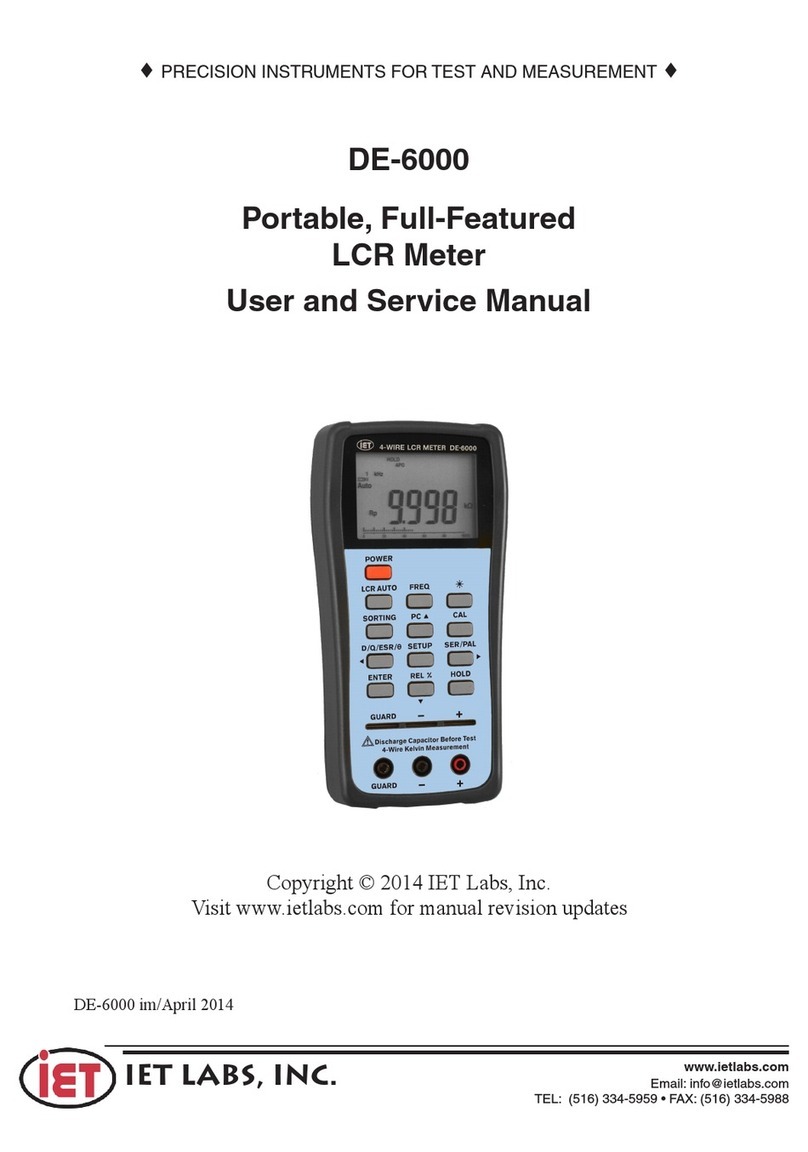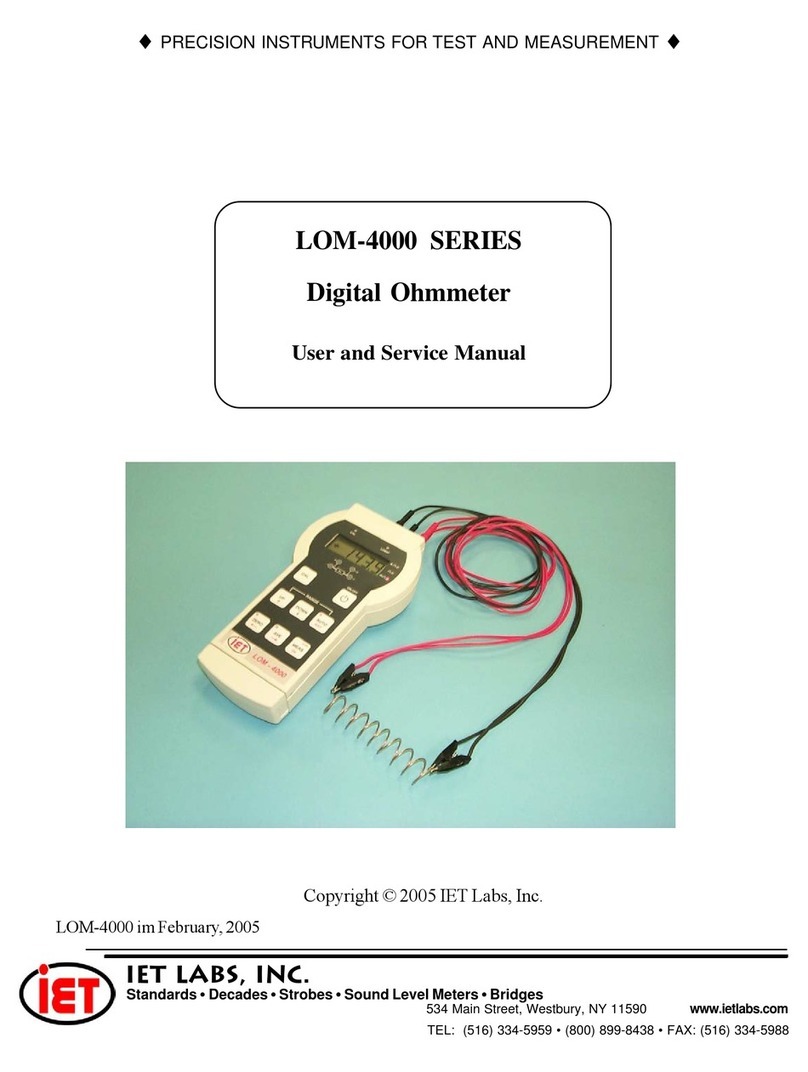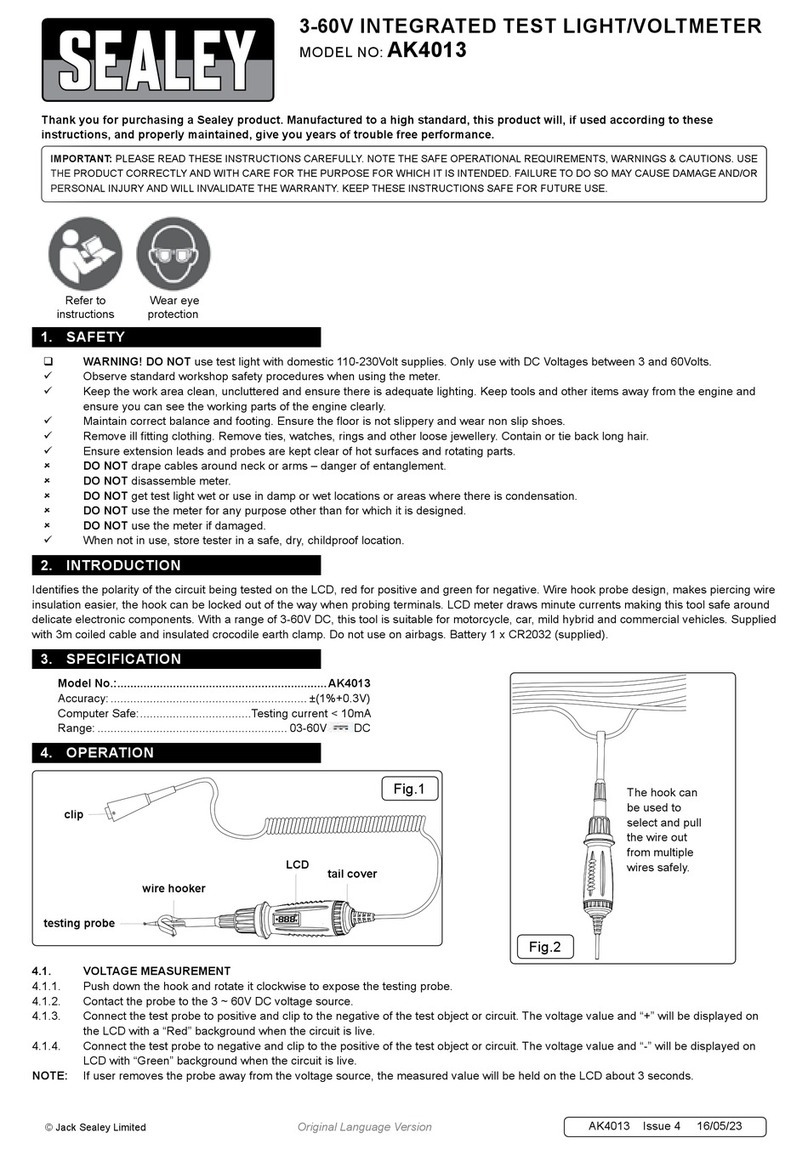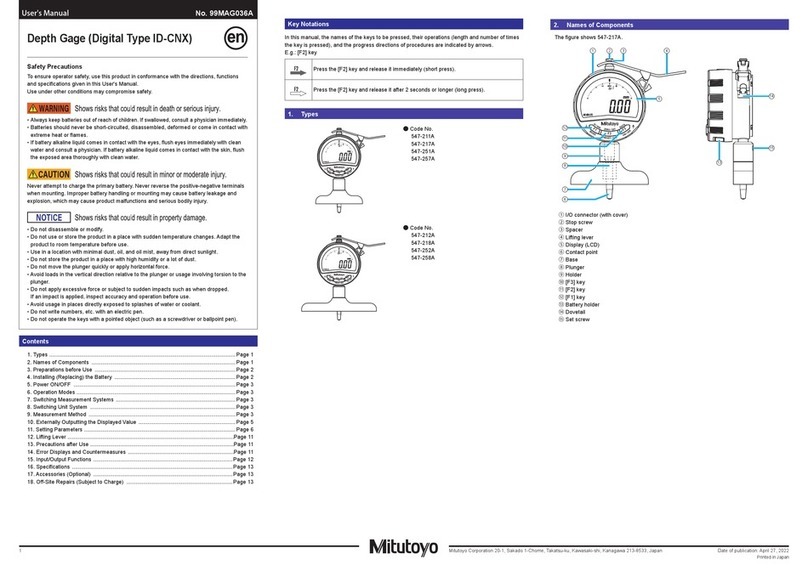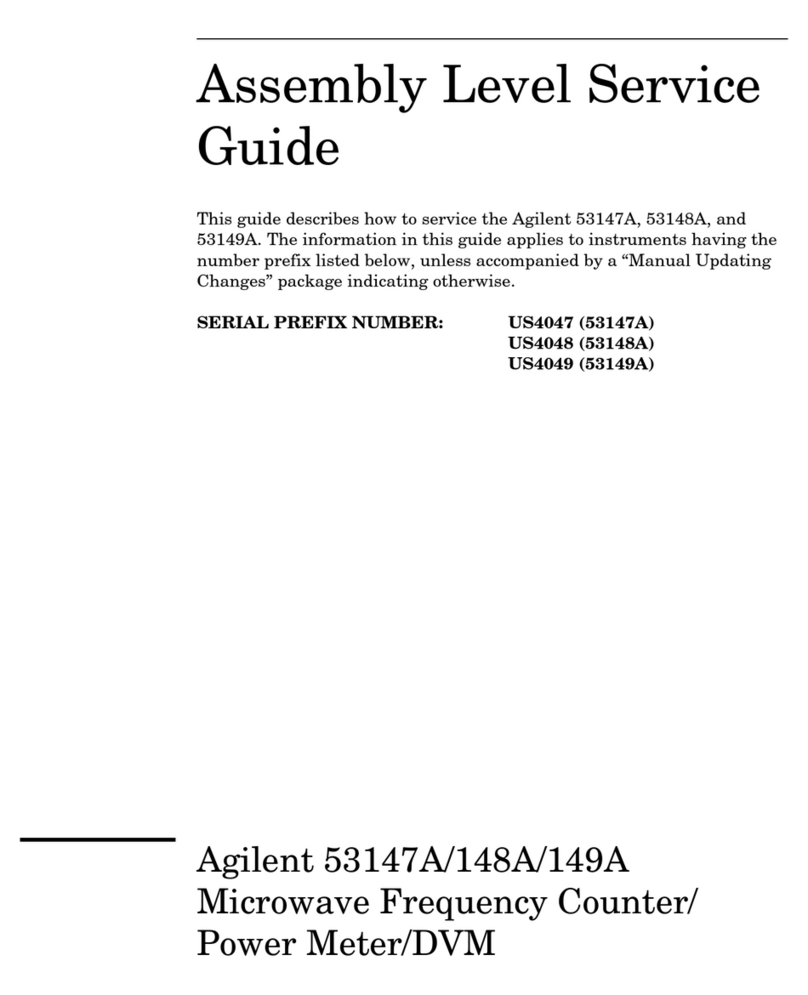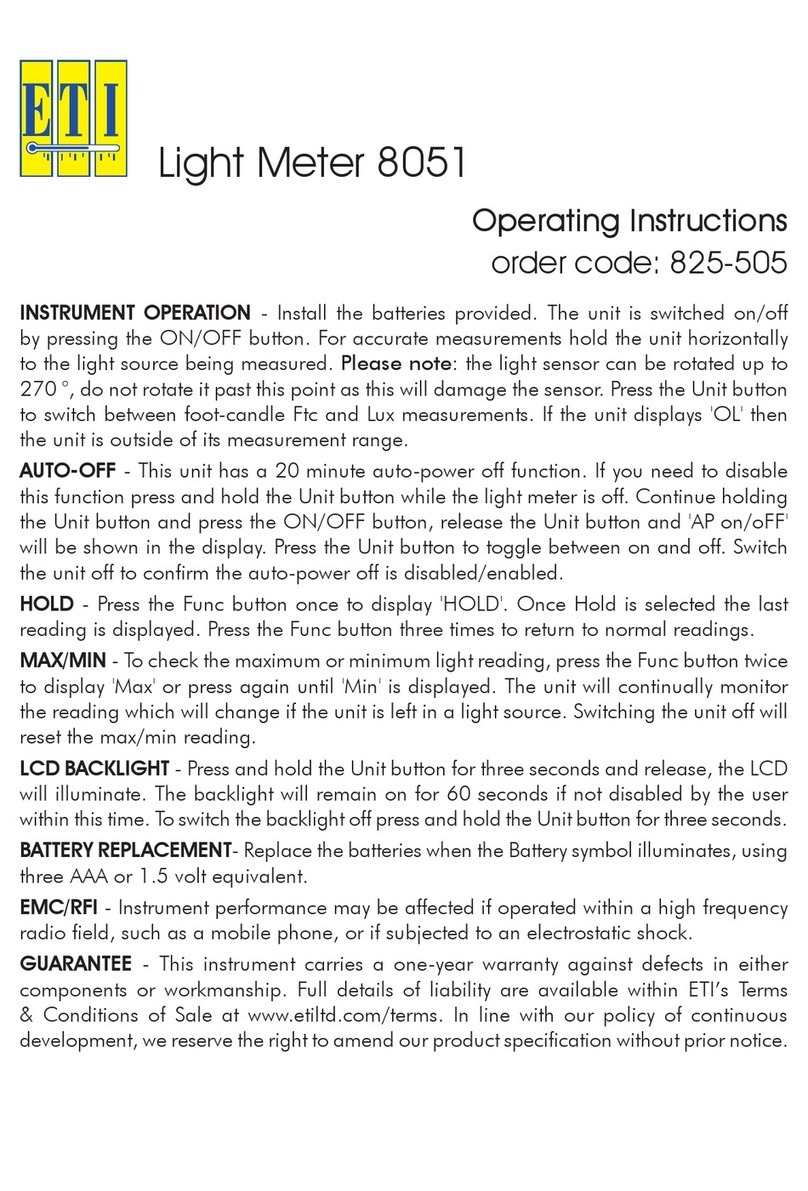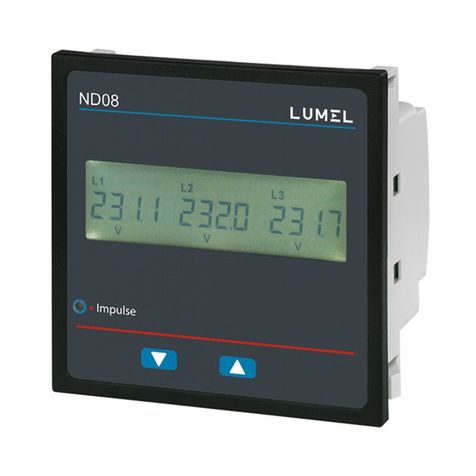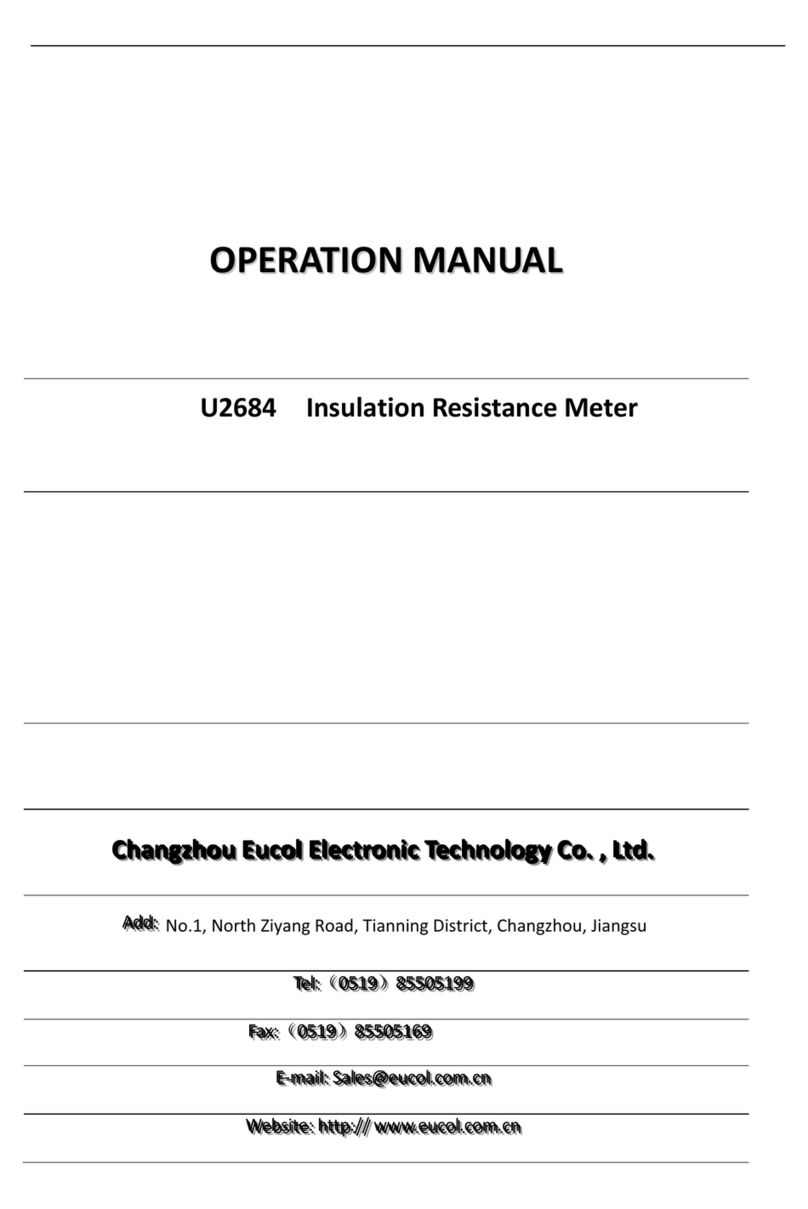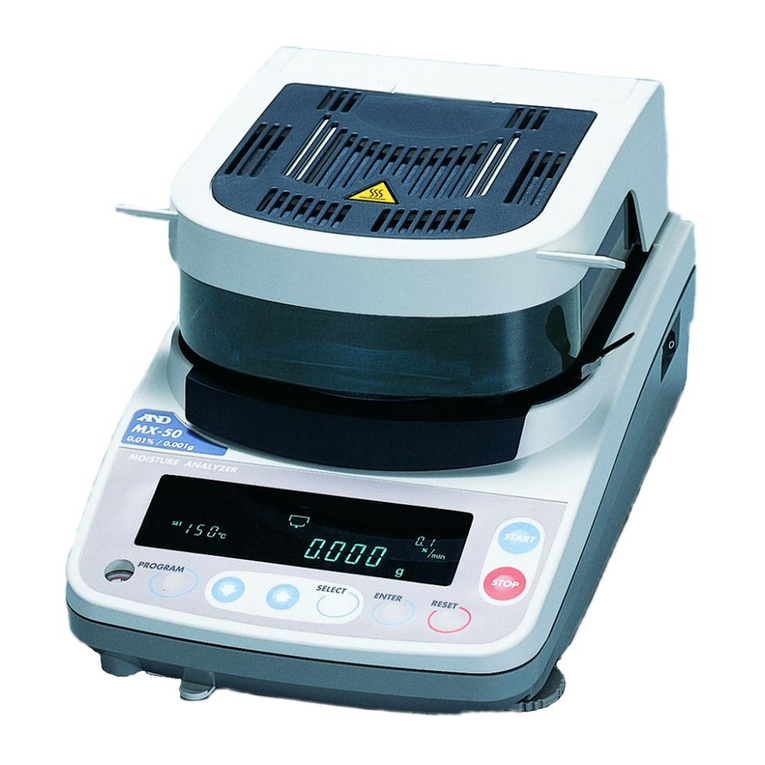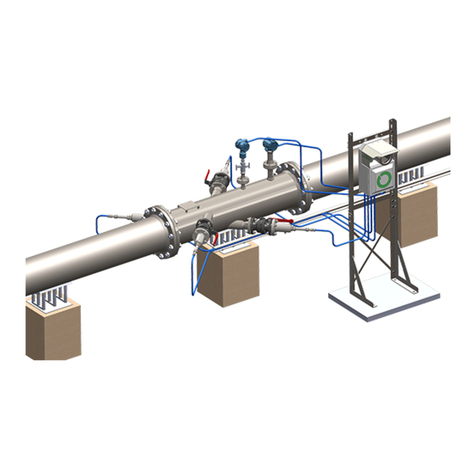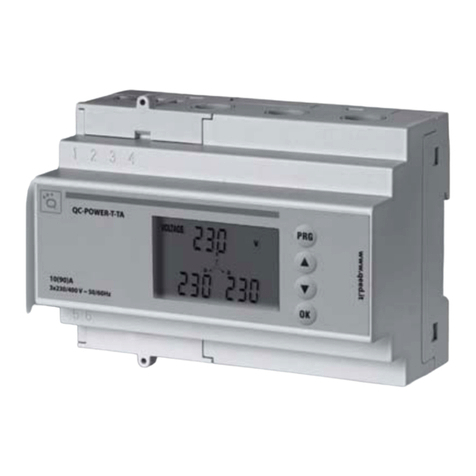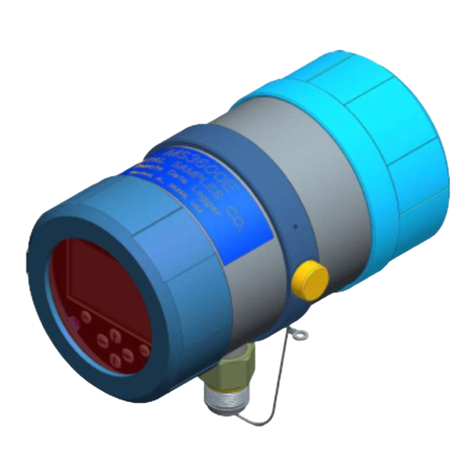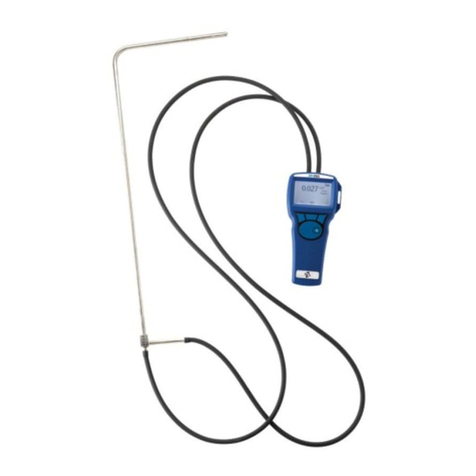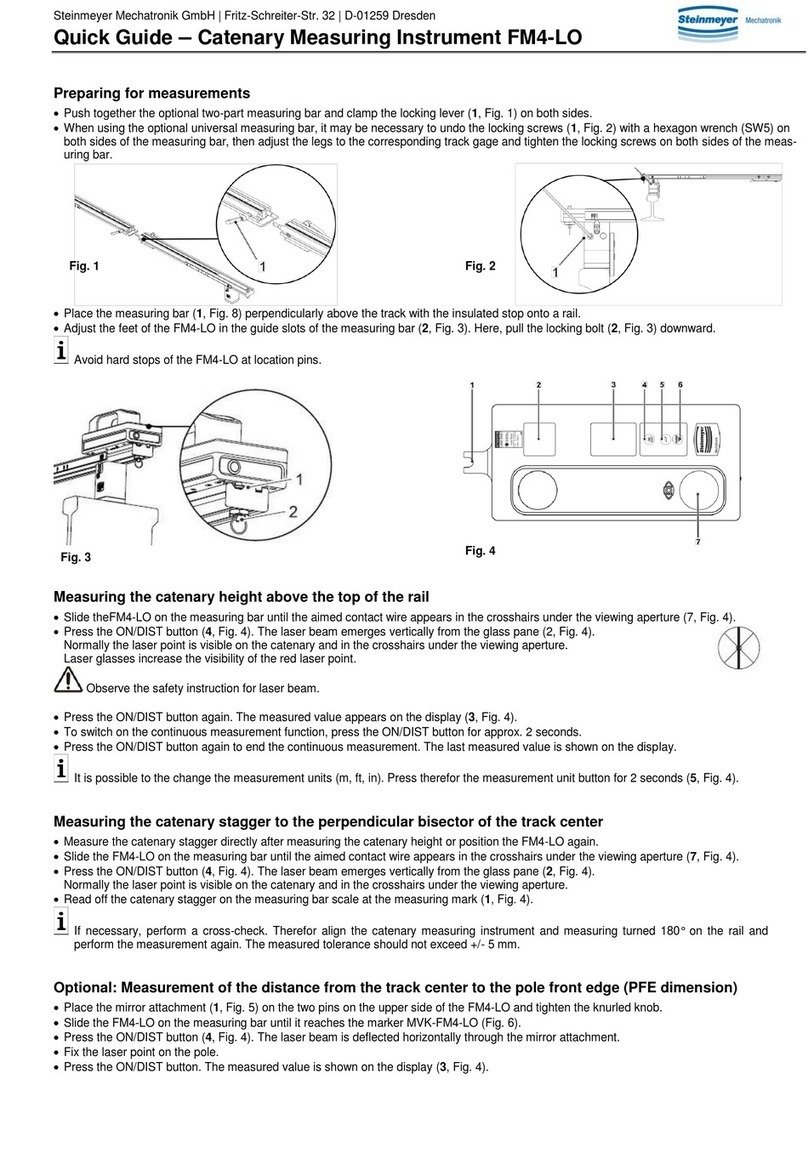iET 1316 Troubleshooting guide

♦PRECISION INSTRUMENTS FOR TEST AND MEASUREMENT ♦
Copyright © 2005 IET Labs, Inc.
1316 im/August, 2005
1316
Oscillator
User and Service Manual
TEL: (516) 334-5959 • (800) 899-8438 • FAX: (516) 334-5988
534 Main Street, Westbury, NY 11590
IET LABS, INC.
Formerly manufactured by
GenRad www.ietlabs.com
Standards •Decades •Strobes •Sound Level Meters •Bridges

♦PRECISION INSTRUMENTS FOR TEST AND MEASUREMENT ♦
TEL: (516) 334-5959 • (800) 899-8438 • FAX: (516) 334-5988
www.ietlabs.com
534 Main Street, Westbury, NY 11590
IET LABS, INC.

iii
WARRANTY
We warrant that this product is free from defects in material and workmanship and, when properly used, will
perform in accordance with applicable IET specifications. If within one year after original shipment, it is found
not to meet this standard, it will be repaired or, at the option of IET, replaced at no charge when returned to IET.
Changes in this product not approved by IET or application of voltages or currents greater than those allowed by
the specifications shall void this warranty. IET shall not be liable for any indirect, special, or consequential
damages, even if notice has been given to the possibility of such damages.
THIS WARRANTY IS IN LIEU OF ALL OTHER WARRANTIES, EXPRESSED OR IMPLIED, INCLUD-
ING BUT NOT LIMITED TO, ANY IMPLIED WARRANTY OF MERCHANTIBILITY OR FITNESS FOR
ANY PARTICULAR PURPOSE.

vii
WARNING
OBSERVE ALL SAFETY RULES
WHEN WORKING WITH HIGH VOLTAGES OR LINE VOLTAGES.
Dangerous voltages may be present inside this instrument. Do not open the case
Refer servicing to qulified personnel
HIGH VOLTAGES MAY BE PRESENT AT THE TERMINALS OF THIS INSTRUMENT
WHENEVER HAZARDOUS VOLTAGES (> 45 V) ARE USED, TAKE ALL MEASURES TO
AVOID ACCIDENTAL CONTACT WITH ANY LIVE COMPONENTS.
USE MAXIMUM INSULATION AND MINIMIZE THE USE OF BARE
CONDUCTORS WHEN USING THIS INSTRUMENT.
Use extreme caution when working with bare conductors or bus bars.
WHEN WORKING WITH HIGH VOLTAGES, POST WARNING SIGNS AND
KEEP UNREQUIRED PERSONNEL SAFELY AWAY.
CAUTION
DO NOT APPLY ANY VOLTAGES OR CURRENTS TO THE TERMINALS OF THIS
INSTRUMENT IN EXCESS OF THE MAXIMUM LIMITS INDICATED ON
THE FRONT PANEL OR THE OPERATING GUIDE LABEL.

Specifications
Frequency:
10
Hz
to
100
kHz
in
4 decade ranges.
Controlled
by
one
11-position
and
one
10
-position
switch
for
the
most-significant
digits
and
a
continuously
adjustable
dial
with
detented
zero-
position
for
the
third
digit;
in-line
readout
with
decimal
point
and
frequency
units
.
Accuracy:
::!::
1%
of
setting~
Drift
(t
ypical
at
1 kHz),
warmup
0
.1
%,
shor
t-term
(10
min)
0.001%,
lon
g-term
(12
h)
0.0
05%.
Resettability,
within
0.005%.
Power
Output:
Controlled
by
5-posi
tion
switch
a
nd
uncalibrated
ve
rni
er.
Monitored
by
meter
with
::!::3%
.accuracy.
Available
at
rear
BNC
connector.
+with
continuously
adjustable
dial
set
at
zero
detent
position.
Output
Range
Open
circuit,
rms
1.s v i s v .I
1s
v 1
so
v 1 1so v
===
1.25 v-
===
4 v 1
===
12.s v 1
===
4o
v 1
===
125 v
Distortion
< 0.2%
from
100Hz
to
10kHz
Hum
0.003%
of
max
out
put
Resoonse
IO
Hr
IOO
Hr
lt~;Ht
IOOIII:Hz
f'fiEOUfNCY-
Hr
IJ16-1
Short
Circuit
Distortion
output
constant
within
±2%
from
10
Hz
to
50
kHz,
±5%
for
frequencies
>50
kHz
5A
I 1.6 A J
0.5
A j
0.16
A I 0.05 A
< 0.2%
from
100Hz
to
10kHz
Synchronization:
Input,
frequency
can
be
locked
to
external
signal;
lock
range,
::!:
1%
/V
rms
i
nput
up
to
10
V:
frequency
controls
func-
tion
as phase
adjustment.
Output,
==:o.3
V
rms
beh
ind
27
kO; use-
ful
to
sync
oscilloscope
or
to
drive
a
counter
or
another
osci
ll
ator
.
Single
rear
BNC
con
ne
ctor
serves as
both
input
and
output
Impedance
0.25
{l
l 2.5 0 l 25 0 j
250
0 l 2.5
kO
terminal.
·
Power
1.6
W
nominal
in
to
ma
tche
d load
Reference
Outputs:
Quadrature
output
lags
go•.
Each
availab
le
at
rear
BNC
connec
tors
. 1n-phase
output
by
Power: 100
to
125
and
200
to
250
v,
50
to
60
Hz,
36 W.
Mechanical:
Bench
or
rack
mount.
Dime.1sions (w X h x
d):
Bench,
19.75 X 5 X
13.06
in.
(502 X 127 X 332
mm);
rack,
19
X 3.47 X
11.44
in.
(483 X 88 X 291
mm)
. Weight:
Bench,
26
lb
(12 kg)
net,
32
lb
(14 kg)
shipping;
rack,
21
lb
(10 kg) net,
27
lb
(12
kg)
shipping.
-::--:---;---
-----:-
-
-:-:-
--
--
-
~
-l_n·
_
Ph
_
a~s-::e:::-
_
1
Quadrature
Output,
open-circuit
1.25 ::!:0.25 V
rms
Distortion,
100
Hz
to
10
kHz
- <- 0- .
-:-
2
-:-%.,--
-'1
<
0.4%
Response,
10
Hz
to
10
kHz
_
__
__
:t_2:-
0
:".Vo:_
_ _
__
_
10
kHz
to
100
kHz
:t4%
-----
Minimum
Load 47 kO
---GenRad
WARRANTY
Catalog
Number
1316-9700
1316-9701
Description
1316
Oscillator
Bench
Model
Rack
Model
We
warrant
that
this
product
is
free
from
defects
in
material
and
workmanship
and,
when
properly
used,
will
perform
in
accordance
with
GenRad's
applicable
published
specifications
.
If
within
one
(1)
year
after
original
shipment
it
is
found
not
to
meet
this
standard,
it
will
be
repaired
or
at
the
option
of
GenRad,
replaced
at
no
charge
when
re
turned
to
a
GenRad
service
facility.
CHANGES
IN
THE
PRODUCT
NOT
APPROVED BY
GENRAO
SHALL
VOID
THIS
WARRANTY.
GENRAD
SHALL
NOT
BE
LIABLE
FOR
ANY
INDIRECT,SPECIAL,
OR
CONSE-
QUENTIAL
DAMAGES, E
VEN
IF NOTICE
HAS
BEEN
GIVEN
OF
THE
POSSI-
BILITY
OF
SUCH
DAMAGES.
THIS
WARRANTY IS
IN
LI.EU
OF
ALL
OTHER
WARRANTIES, EXPRESS
OR
IMPLIED,
INCLUDING,
BUT
NOT
LIMITED
TO
,
ANY
IMPLIED
WARRANTY
OF
MERCHANTABILITY
OR
FITNESS
FOR
A PARTICULAR PURPOSE.
SERVICE
POLICY
Your
local
GenRad
office
or
representative
will
assist
you
in
all
matters
relating
to
product
maintenance
,
such
as
ca
librat
ion, repair,
replacement
parts
and
service
contracts.
GenRad
policy
is
to
maintain
product
repair
capability
for
a
period
of
five
(5)
years
after
origin
.
al
shipment
and
to
make
this
capabi
li
ty
available
at
the
then
prevailing
schedule
of
charges.
NOTE
The
material
in
this
manual
is
for
informational
purposes
only
and
is
subject
to
change
without
notice.
GenRad assumes
no
responsibility
for
any errors
or
for
consequential
damages
that
may result
from
the
use
or
misinterpretation
of
any
of
the
procedures
in
this
publication.


Introduction-Section
1
1.1
PURPOSE
1.2 DESCRIPTION . . . . . . . . . . . . .
1.3 CONTROLS, CONNECTORS,
AND
INDICATORS .
1.4 SYSTEMS . . . . . .
1·1
1-1
1-1
1-1
1
-1
1.5 ACCESSORIES SUPPLIED . .
1.1
PURPOSE.
The Type 1316
Osci
llator
is
a high-performance instru-
ment with
an
output
of
10 Hz
to
100 kHz.
It
was
specifically designed
for
use
wi
th
the
Ty
pe
1238 Detector
and
the Type 1616 Precision Capacitance Bridge,
and
is
also
an
excellent
general
purpose instrument.
1.2 DESCRIPTION.
The 1316 Oscillator
is
a decade-conductance-tuned,
Wien-bridge oscillator containing a low-distortion power
amplifier that
is
transformer coupled
to
provide isolation
from
th
e load. Output power and frequency are
se
lected
by
front
-pa
nel
controls;
al
l external connections
are
made
to
the
rear
pane
l
for
clutter-free operation.
A provision
to
introd
uce
or
extract a synchronizing
signal
is
included in the oscillator circuit. The extracted
signal
is
independent
of
the
output
setting and
can
be
used
to operate a counter
or
to
synchronize
an
oscilloscope.
Other features
are:
unambiguous in-line
re
adout,
dec-
ade-frequency selection
with
positioned decimal
po
int
and
units,
and
two
reference outputs (IN-PHASE
and
OUAD-
RATUR
E).
The
re
ference outputs
are
for
use
with
the Type
1238 phase-sensitive Detector.
1.3 CONTROLS, CONNECTORS, AND INDICATORS.
The front-
and
rear
-p
anel
c
ont
rols, connect
ors
and
indicator
are
shown
in
Figures 1
-1
and
1-2
respectively.
Refer
to
Tables 1
-1
and
1
-2
for
a functional
and
physical
description.
1.4 SYSTEMS.
The 1316
osci
llator
is
used
as
a component in the
1621
Pre
cision Capacitance
Measure
me
nt
System (Figure 1-3).
1.5 ACCESSORIES SUPPLIED.
A 3-wire, 7-ft power cord (P/N 4200-9625)
is
supplied
with the instrument.
INTRODUCTION
1-1

4 5 6 7 8
Figure 1·1. Front-panel controls, connectors·and indicators.
-------------------------------------Table1-1-------------------------------------
Figure 1·1
Ref.
No.
2
3
4
5
6
7
8
9
10
Name
POWER
swit
ch
FREQUENCY
se
lec
tor
FREQUENCY
se
l
ector
FREQUENCY
se
lec
tor
FREQUENCY
r
ange
swit
ch
OUTPUT
VOL
TAGE
RANGE
switch
Voltmet
er
OUTPUT
ADJUS
T
contro
l
1-2
INTRODUCTION
FRONT
PANEL
CONTROLS
AND
INDICATOR
Description
2-
position
toggle
switch,
down
position:
OFF.
10-
position
rotary
switch, dial-marked
1
to
10
.
11-position
rotary
switch,
dial
mark
ed
0
to
9 and X
(X
i
nd
icate$
10
or
0).
Stepless
potentiometer,
dial marked
0
to
9
with
detent
at 0.
4-position
switch,
dial marked Hz, H
z,
kH
z, and kHz.
5-position
rotary
switch,
panel-marked
1.5, 5.0,
15
.0, 50.0, a
nd
150
.
Ac
meter
wit
h
0-15
and 0-50-V
scales.
Steple
ss,
rotary
potentiom
eter
with
limits
labeled 0 and
MAX
.
Zero-adjust screw.
Front
-panel,
white
indi
cator
lights.
Function
Turns instrument
on
or
off
.
Se
lects and
indi
ca
tes 1st di
git
of
frequency.
Se
lects and indicates
2nd
digit
of
fr
e
qu
ency.
Se
lects and indicates
3rd
digit
of
frequency.
Se
lects frequency range, indicates
unit
s,
and c
ontrols
illuminated
decimal
point
.
Se
lects output-voltage range and
indicates
full-s
cale meter range
(item
7). Simultaneously switches
the
outp
ut
impedance
from
0.
25
n
to
2.5
kU in decade steps.
In
dicates
output
terminal
voltage,
in
ranges
sel
ected
by
it
em
6.
Co
ntrol
s
output
le
ve
l in the range
selected
by
it
em 6.
Mechanically adjusts
output-
voltage meter
for
mechanical zero.
Indi
cates posi
tion
of
decimal
point,
co
ntrolled
by
the
FRE
-
QUENCY
range switch
(item
5).

figure 1-2.
Rear
-
panel
control
and
connectors
.
-------
--
----------Table
1-2-----
- -
--
----
-
-----
Figure
1·2
R
ef.
No.
2
3
4
5
6
7
REAR-
PANEL
CONTROLS
AND
CONNECTORS
Na
me
D
esc
ription
QUADRATURE
REFEREN
CE
BNC jack
OUTPUT
IN-PHASE REFEREN
CE
OUTPUT
BNC jack
EXT
SYNC connector BNC jack
P
OW
ER OUTPUT connect
or
BNC j
ack
Fuse
Bussma
n MDL
8/
10
A,
slo-
blo
5Q-60 Hz Two-pos
iti
on s
li
dt.
10
0
V-
1
25
V
sw
it
ch
2
00
V-
25
0 V
Th
ree
-pin power plug
Fun
ction
Provi
des
a reference output that l
ags
the
"i
n
-p
hase" reference by 90° at 1.25 V o.c.
Provides a reference
output,
in
-p
has
e
wi
th
power
output,
at 1.25 V o.c.
For synchronizing
outp
ut f
req
uency
to
an
external source (lock r
ange
is ±1%/Vr
ms
, up
to
10
V)
or
constant-amplitude sig
na
l source
(0.3 V behind
27
knl.
Main output, 1.6 W nominal m
ay
be 125 V o.c.
or 5 A s.c.
Pr
ote
cti
on.
aga
inst
damage
from a sh
ort
c
ir
-
cu
it
for
110-
or
220-V operation.
Switches line power
co
nn
ec
ti
on
f
or
either
11
0-V
or
220-V operati
on
.
Accepts 3-wi
re
li
ne
cord to power
instrument.
INTRODUCTION 1-3

1-4 INTRODUCTION
~
...
_,.,.. ,IN
-
··
-·I
..
'
-..
...
lVIII
Figure 1-
3.
Type
1621 Precision Capacitance-MeasurementSystem.

Installation-Section
2
2.1
GENERAL
2.1
GENERAL . . . . . .
2.2 DIMENSIONS . . . . .
2.3 POWER-LINE CONNECTION
2.4 BENCH MODELS . . . .
2.5 RACK MODELS . . . .
2.6 LINE-VOLTAGE REGULATION .
2.7
EXTERNAL
CONNECTIONS . .
The Type 1316
Osci
lla
tor
is available
for
either bench
use
or
installation in
an
E
IA
Standard
RS
-310,19-in. relay
r
ack
with
universal hole
spacing
. Appropriate cabin
et
and
hardware
se
ts
are
ava
il
ab
le
for
conversion of a bench model
for
rack installation
or
vice
ve
rsa
.
2.2 DIMENSIONS.
O
utl
ine
drawings showi
ng
overall dimensions
of
the
os
cillator in bench
and
rack models are shown
in
Figure
2-1.
2.3 POWER-LINE CONNECTION.
Power requirement is 36 W
at
100 to 125
or
200
to
250
V,
50
to
60Hz.
Make
co
nnections
as
fo
llows:
a.
Se
t the line-voltage
swi
tch on
th
e r
ear
panel
to
correspond with
th
e
avai
l
ab
le power-line voltage.
Use
a
sma
ll screwdriver to slide the switch.
b. Connect
th
e external power line
to
the power plug,
using the power
co
rd suppl
ied
or
an
equivalent, 3-conduc·
tor
co
rd.
A single
8/
1
0-
A
fuse
protects both the low· and
high-voltage circuits.
2.4 BENCH MODELS.
2.4.1 General.
2·1
2·1
2-1
2·1
2·2
2·4
2-4
E
ac
h bench model
comes
completely
as
semb
led
in
a
metal cabinet intended f
or
use
on a table
or
laboratory
ben
ch.
Th
e instrument
is
mounted on tracks that permit
easy
removal
for
inspection
or
repair.
2.4.2 Cabinet
Removal
.
a.
Set
th
e instrument in the horizontal posi
tion
, free of
unnecessary c
ables.
b.
Remove
the
four
dress-pane
l
screws
(A),
accessib
le
th
rough holes in the handles.
c.
Carefully pull the
ins
trument
out
of
the cabinet.
2.4.3
Conversion
for
Rack
Mounting.
To convert a
be
nch ins
tr
ume
nt
for
rack mounting,
exchange
th
e cabinet and i
nstal
l appropriate
ha
rdware,
as
follows:
a.
Ob
t
ain
a Rackable Cabinet Assembly PIN 4174-3240
(Table 2-1)
fr-om
General
Rad
io Company.
b.
Obtain, optionally, Bracket Set P/N 4174-2007 (Table
2·2). Th
is is
espec
ially recommended
for
a
heavy
instrument,
which
needs
support from the
rear
rail
of
the rack.
INSTALLATION
2·1

I.
19
.8 BE
NC
H MODEL
1 t
FRONT PANEL c
DIM.
A
B
c
D
END
VIEW
INCHES
11
.562
12
.837
4.
031
4.906
J D
1
J~'
ro'"~
1I
DI
M.
INCHES
p
13.640
Q
11.749
R
13.062
1r
-TOPVIEW
,
__1
, s 1.
625
W
L=f-J
T
3.469
19
RACK
MODEL
~
FRONT PANEL
~
l
~
END VIEW
T
l
Figure 2-1. Dimensions
of
the
1316
bench
and
rack·model
instruments
.
c.
Remove
the
cabinet,
as
in
paragraph 2.4.2.
d. Remove the rear cover
from
the bench cabinet,
wit
h
sc
r
ews
(B
Figure 2-2} ,
for
later installation on the rack
cab
inet.
e. Proceed
with
the
ra
ck installation; skip
to
paragraph
2.5.2, step b.
2.5 RACK MODELS.
2.5.1 General.
E
ac
h rack model
comes
completely assembled in a
suitable metal cabinet, which isdesigned
to
stay
sem
iperma-
nently
in
a rack. The instrument
can
be
drawn forward on
extending tracks
for
access
with
support,
or
(wi
th
a
lift}
withd
rawn completely. The cabinet and hardware li
sted
in
Tables
2-1
and 2-2 are all included
with
a
ra
ck-model
instrument.
2.5.2 Installation. Figure 2·3
Directions
fo
-
llow
fo
r mounting the cabinet in a rack and
installing
th
e instrument on
it
stracks:
a.
Remove 4 dress-panel screws (A)
and
slide the
in
strument
out
of
the
cab
in
et
until
the tracks
are
fully
extended.
Co
ntin
ue
pulling the instrument forward
unti
l
motion
along the tracks
is
stopped.
At
this juncture,
tilt
the
f
ront
of
the instrument up slig
htl
y
and
continue
with
-
drawal, past the stops,
unt
il it
is
free.
2-2
INSTALLATION
b.
Insert the
rack
cab
inet wherever
desi
red
in
the
rack
-
be
su
re
it's level - and fasten it
with
4
screws
(C)
to the
front
rai
ls
.
c. If the rack contains a rear support
rai
l,
use
brackets
(0)
to support the
cab
inet
with
th
e rear rail
s;
open-slotted
screw holes allow positioning.
d.
Use
the
se
t
of
slots
in
the si
des
of the
cab
inet that
allow alignment
of
the open-slotted holes in the brackets
with
threaded h
oles
in the
rai
l. The long fl
ange
should ex-
tend
to
the rear.
e.
Insert
screws
(E)
from inside the cabinet, through the
slotted holes and
dr
i
ve
them i
nto
the hol
es
in the long
flange of the bracket.
Each
si
de
takes 2.
--------Table
2·1--------
RACKABLE CABINET ASSEMBLY
(P
/N
4174-3240)
Quan-
tity
Description
Hardware set, including:
2 Screws, 0464-32, 1/4-in, thread
for
ming
("B"
for
rear cover).
4 Screws, 0.1
90
-32,
9/16
in,
dress
("A"
for
front
panel).
4
Sets
of
10-32 nutsand
was
hers
(for
screws
"A",
if
needed).
4174-2004

REAR
COVER
BENCH·
CA
BINET
ASSEMBLY
SLIDE
BLOCKS 417.0
Figure 2·2. Bench-cabinet installation.
NOTE
S
ta
rt
the screws in the ap
pr
o
pr
iate hol
es
off
the
rack, to make
th
e threading
easier
.
f.
Pass
sc
rews (B)
thr
ough brackets
and
screw 2 in
to
each
rear rail. (Details may
be
varied
to
suit particular
situa
tion
s.)
g.
To
install the
ins
trument, first
set
its rear
edge
in the
cabinet
front
opening. Slide the ins
tr
ument back, making
sure that
the
r
ea
r
and
the upper front slide blocks
enga
ge
the tracks. (Stops prevent further insertion.)
h.
Pul
l the instrument forward with the tracks, keeping a
hand
on
each
side (fingers underneath). Slide the instru-
ment back about
%in
. along
both
tracks, past the stops,
by
pressing down
on
the
tr
acks (w
ith
thumbs) while
tilt
ing
th
e
f
ront
of
the
i
nstr
um
e
nt
up
sl
igh
tl
y.
i.
Pus
h the instrume
nt
back i
nt
o the rack, checking
for
smooth o
pe
ra
t
ion
of
the trac
ks
and
sl
ide blocks.
NOTE
T
he
instrument
is
now
read
ily accessible
for
behind-the-panel
ad
justments.
It
slides in and
out
fr
ee
ly on extendi
ng
tracks.
B
FR
ONT
RAIL
RACK
·C
ABINET
ASSEMBLY
-------Table
2·2
--------
BRACKET
SET FOR RACK
MODEL
(P
/N
4174
-2
007)
R
ef
Quan
tity'
Descrip
lion
D 2 L brackets
with
open-slotted holes.
E 4 Screws, 8-32. 3
/1
6 in., thread forming.
C, B 8 Screws, 10-32, 1
/2
-in., t
hr
ead forming.
2.5.3
Conversion
for
Bench
Use.
To
convert a
ra
ck-mounting instrument
for
bench
use,
exchange the cabinet,
as
follows:
a. Obtain a Bench Cabin
et
assembly P/N 4172-4015
(Table 2
·3
)
fr
om
General Radio Company.
b. Remove
th
e instru
me
nt from the rack
ca
bin
et, using
the procedure in step
a,
para. 2.5.2.
c.
Sta
nd
the instrument fa
ce
down, to rest on its
handles,
and
slip the bench
ca
binet
over it. Carefully return
it
to a
hor
izo
nt
al positio
n.
A
Figure 2·3. Rack
-ca
binet installation.
INSTALLATION
2-3

d.
Fas
ten the instrument
to
the cabinet
usi
ng
dress-pa
nel
screws
(A, Figure 2-2).
e.
Transfer
th
e rear
cove
r,
with
screws (B), from rack
cab
in
et
to
bench
cab
in
et.
2.6 LINE-VOLTAGE REGULATION.
The accuracy
of
measureme
nt
s accomplished wi
th
pre-
cision electronic test
equ
ipment operated
from
ac
line
sources
ca
n
ofte
n
be
seriously degraded
by
flu
ctuat
io
ns
in
prim
ary
input
power. Line-voltage variations of ±15%
are
commonly encountere
d,
eve
n in laboratory environments.
Altho
ugh
most mod
ern
ele
c
tronic
i
ns
trum
e
nt
s in
co
rporate
some
de
gr
ee
of
regulation, possible power-sour
ce
problems
should
be
considered f
or
eve
ry ins
tru
mentation setup. The
use
of
lin
e-
voltage r
egu
la
tor
s between power l
ines
and
the
test
eq
uipment
is
recommended as the only s
ur
e way
to
rule
out
the effects on
measur
ement data
of
va
riations in
I
in
evol
tage.
2.7
EXTERNAL
CONNECTIONS.
2.
7.1
General.
All
ex
ternal
co
nne
ctions
to
the Type 1316
Osci
llator
are
made to rear-panel BNC connec
to
rs.
Th
is
feature facilitat
es
th
e
use
of
the 1316 in
th
e Type 1
621
Prec
is
ion-Capaci-
tance-Measurement
Sys
tem (Figure 1-3).
2.7.2 POWER OUTPUT Connector.
The
ma
in out
put
of
th
e
osci
llator is
ava
ilable at
th
e
r
ear
-p
anel P
OW
ER
OU
TPUT jack. Output-voltage
range
and
amplitude are con
tr
olled
by
th
e front-panel OUTP
UT
VOLTAGE
RAN
GE
and OU
TP
UT
ADJ
UST c
ontro
ls r
e-
spectively.
2.7.3
EXT
SYNC Connector.
A
si
ng
le r
ea
r-
pane
l BNC connector
serves
the dual
purpose
of
an
in
put
or
output
jack. As
an
input,
th
e
osci
ll
ator
fr
eq
ue
ncy c
an
be
locked
to
an
ex
ternal signa
l.
2·4
INSTALLA
TION
T
he
lock range
is
±1%/V
rms
in
pu
t.
up
to
10 V,
and
the
front
-
pane
l frequency controls func
ti
on
as
th
e
phase
adjustment. As
an
output
,
0.
3 V
rms
behind 27
kQ
is
avai
lable
to
lock
th
e frequency of another instrume
nt
to
th
at
of
the
asci
llator.
2.7.4 REFERENCE OUTPUT Connectors.
General. T
he
REFERENCE
OU
TPUT
co
nnectors were
designed
into
the
Osci
llator pri
ma
rily
to
provide low-l
eve
l
fixed-amplitude refer
ence
sig
nals
for
the Type 1238 Det
ec-
tor. However,
th
ey
ca
n
be
used
for
any appli
ca
tion
requiring a pair
of
1-V reference
signa
ls w
ith
a ph
ase
dif
ference of 90°.
IN
·PHASE. T
he
IN-PHASE o
utput
jack provides a
refer
ence
vol
tage
that
is
in ph
ase
w
ith
th
e main
POWER
OUTPUT
of
the 1316
Osci
llator. Thisvoltage (open c
ir
cu
it)
is 1.25
±0
.2
V
rms
. Distortion is
less
than 0.
2%
from 1
00
Hz to 10 kHz and the vo
lt
age
re
sponse
is
typi
ca
lly
±2%
from
10H
z to 10 kHz,and ±4%
fr
om
10kH
z
to
100kHz.
The
minimum load impedance should.be
47
k
0..
A smaller
impedan
ce
will redu
ce
the
output
voltage
and
poss
ibly
cause
distortion.
--------Table
2·3
--------
BENCH
CABINET
ASSEMBLY COMPLETE (4172-4015)
Quan·
tity
Description
Pa
rt
No.
1 Bench
Cabi
net
Assemb
ly, including:
4172
-2
042
1
Ca
binet
1
Gas
ket
1
Ba
se
with
hardware (includes
hinge
and
t
ogg
l
es
)
Fa
c
tory
assemb
l
ed
w
ith
:
2 Tracks
2 Bra
ck
ets,
rear
, (and
sc
rew
s)
Supplied w
it
h:
2 Scr
ews,
0.164
-3
2, 1/4 in., thread
forming
("B"
f
or
rea
r c
ove
r)
4
Sc
r
ews.
10-
32,
9/
16
in.
,
dress
("A"
f
or
fro
nt
panel)
OUADRATURE.
Th
e
OUADRA
TURE out
put
jack pro-
vides a referen
ce
vo
lt
age
that
leads
the IN-
PH
ASE and
POW
ER
OUTPUT vol
tages
by
90°. This voltage (open
circuit)
is
1.25 ±0.2 V rms. Distortion is l
ess
than 0
.4%
fr
om 100
Hz
to
10 kHz
and
the voltage
response
is
ty
pically ±4% from
10kHz
to
100kHz.
The
minimum
lo
ad
impedance shouldbe
47
kQ
.

INSTALLATION
2-5

2·6 INSTALLATION
NOTE
The instrument
is
fitted with a new-design power·
connector
that
is
in conformance with the Inter·
national Electrotechnical Commission publication
320. The 3 flat contacts are surrounded by a
cylindrical plastic
shroud
that
eliminates the pos·
sibility
of
electrical shock whenever
the
power
cord
is
being unplugged from
the
instrument. In
addition, the center ground pin
is
longer, which
means
that
it
mates first and disconnects last,
ensuring greater user protection from electric
shock.
The panel connector
is
a standard 3-pin ground·
ing·type,
the
design
of
which has been accepted
world wide
for
electronic instrumentation, and
is
rated
for
250 V
at
SA.
It
also meets require·
ments
of
Underwriter's
laboratories
in the U.S.
and
the
Canadian StandardsAssociation. The
receptacle accepts power cords fitted with the
Belden type SPH-
386
connector.

Operation-Section
J
3.1
GENERAL
3.1
GENERAL
. .
3.2
OPERATIONAL
CHECKS
3.3
NORMAL
OPERATION
3.4 APPLICATIONS
This section contains operational chec
ks,
operating
i
ns
tructions,
and
a basic description
of
some applications
fo
r which the 1316
Osci
llator
can
be
used.
3.1.1 Equipment Turn-on.
To
prepare the instrument
fo
r
use
, perform
th
e
fo
ll
ow
-
ing
steps:
a.
Set
th
e rear-
pane
l line-voltage
se
lec
tor
sw
it
ch to
th
e
lin
e-vo
lt
age
used
(100-1
25
V or 200-
250
V.
50-60Hz),
and
co
nnect the
in
strument to
th
e power line,
us
in
g the power
cab
le suppli
ed.
b. Set the power
sw
itch
to
POWER.
One
of
the
deci
ma
l-
point
lamps should glow. Its pos
it
ion
wi
ll depend
on the FREQUENCY range-switch setting (Refer to Table
3-
1
).
3
.1
.2 Meter Zeroing.
The
output
voltage meter
has
been
zeroed at
th
e factory.
If
it
becomes
ne
cessary
to
re-zero
th
e
me
ter, proceed
as
follows:
a.
Che
ck
to
see
that
th
e
POWER
swi
tch
is
se
t
to
OFF.
If
the instrument h
as
been
operating,
al
l
ow
suffi
cie
nt time
for
the meter indicator
to
stabili
ze
near
zero.
3-1
3-1
3-2
3-2
b.
Adjust the meter zero-adjust screw
for
a zero
indication. Gently tap the meter fa
ce
occasional
ly
during
adjustment.
c.
Se
t t
he
osci
ll
ator controls
for
any
output
with
in the
r
ange
of
the instrume
nt
.
d. Turn on
th
e
osc
ill
ator. Note that an
outp
ut
is
indicated
and
then
turn
of
f
th
e oscillator.
e.
Check
to
see
that
th
e meter indicator stabili
zes
on
ze
ro.
3.1.3Stray Capacitance.
S
tr
ay capacitance
of
most shielded l
eads
or coaxial
cab
l
es
is
about
30
pF per
foot.
which.
at
100kHz,
amounts
to
a shunt impedance
of
about 55 k
!l
Therefore, t
he
cable
l
eng
th
should
be
kept
to
a minimum when a high-im
ped-
ance
load
is
to
be
driven at high frequencies.
3.2
OPERATIONAL
CHECKS.
3.2.1 General.
Th
ese
procedures
can
be
used
for
incoming inspection,
operator familiari
za
ti
on,
or
as
a periodic quick-check on
instrument operation. T
ab
le
5-1
includes recommended t
est
equipme
nt
for
th
ese
c
he
cks. Refer to
para.
5.8 if unable
to
obtain the performance
ca
ll
ed
fo
r.
OPERATION
3-1

--------Table3-1
--------
DECIMAL
POINT POSITION
Position
of
A-55 (from
fully
counterclockwise)
1 (Hz)
2 (Hz)
3 (kHz)
4 (kHz)
• X = a
frequency
dial
3.2.2
Output
Frequency.
POSITION
OF
DECIMAL
POINT*
XX.X
XXX.
X.XX
XX.X
The frequency
of
the oscillator
output
signal should
correspond
with
the setting
of
the FREQUENCY selectors.
For
a quick-check
of
output
frequency proceed
as
follows:
a.
Set the 1192 counter controls
to
measure frequency
and connect
it
to
the oscillator
POWER
OUTPUT jack.
b.
Turn the oscillator on and
set
the frequency selectors
for
any frequency between
10Hz
and
100kHz.
c.
Observe the counter visual register.
It
should display
the
same
frequency set
by
the frequency selectors
±1
count.
3.2.3
Output
Voltage.
The Oscillator
is
equipped
with
an
ac
voltmeter
for
monitoring the
output
voltage. For
an
operational check
of
the
output
voltage, simply
turn
the instrument on,
set
the
frequency and voltage controls for
some
value
within
the
range
of
the instrument,
and
observe the front-panel meter.
This meter
will
indicate the voltage at the
output
jack
within
±3%.
3.3 NORMAL OPERATION.
To
use theinstrument
as
a source:
a.
Turn
on
the oscillator and allow approximately 1
minute
for
it
to
rea
ch normal operating temperature. For
optimum
frequency
and
amplitude stability allow 30-
minutes warmup.
b. Set
the
FREQUENCY
range
switch
to
the desired
frequency range. Notice that this control positions the
decimal point.
c.
Set the FREQUENCY selectors
to
the desired
frequency.
d. Set the OUTPUT VOLTAGE RANGE switch
to
the
range
that
will
provide the desired
output
voltage.
e.
Adjust the OUTPUT ADJUST control
to
obtain the
desired
output
voltage reading on the
output
voltage meter.
To
use the instrument synchronized to
an
external
source.
a.
Perform steps a·e above.
b. Connect the external signal
to
the
EXT
SYNC jack
(Figure 1-2). The lock
range
of
the oscillator
is
±1
%/V rms
sync
input
up
to
10 V. For example,
if
a 1-kHz, 1-V sync
signal
is
used,
the oscillator
output
frequency
will
lock
to
3·2
OPERATION
the external signal
within
the range 990-1010
Hz.
If
the
sync-signal voltage
is
doubled the lock
range
also
doubles
(980·1
020
Hz).
The oscillator
will
remain synchronized
so
long
as
it
is
operated w
ith
in the lock
range.
3.4 APPLICATIONS.
3.4
.1 General.
One
of
the most important fedtures
of
the Type 1316
Oscillator
is
that
it
provide-s
an
easy-to-read, unambiguous,
repeatable, in-line readout
of
its frequency. This
will
be
of
value in production testing and calibrating where many
accurate and repeatable frequencies must
be
selected
quickly.
Some
typical applications
are
presented in the following
paragraphs.
3.4.2 Slaved Oscillators.
Because
the
EXT
SYNC jack
is
simultaneously
an
input
and
an
output
connector,
two
or
more oscillators
can
be
synchronized
or
slaved
by connecting their
EXT
SYNC
jacks together (Figure 3·1). Oscillators connected in this
manner
will
operate at the
same
frequency, or multiple
th
ereof, and
can
be
made
to
differ
in
phase
(180° ±75°)
by
adjustment
of
the frequency selectors
within
the lock
range.
The lock
range
is
±1%/V rms input up
to
10
V.
Another obvious application
is
to
lock one
or
more
oscillators
to
a reference source
that
has
greater accuracy
and
long-term stability. This
is
done
by
connecting the
source
to
the
EXT
SYNC jack.
If
more than one oscillator
is
to
be
used,
connection between instruments
is
shown in
Figure 3·1. With the instrument(s) synchronized in this
fashion accuracy
and
long-term stability
will
be
identical
with
the reference; short-term stability
will
be
the
same
as
if
the oscillator
was
free-running.
3.4.3 Amplitude-Modu
Ia
ted Oscillator.
Amplitude modulation.
if
the oscillator
is
operated
out·
side
of
the lock
range,
the sync
signal
will
beat with the
oscillatorfrequency and produce
an
audio-frequency, ampli·
plitude-modulated
output.
The modulation
will
be
approxi·
mately sinusoidal
for
modulatian levels up
to
about
10%.
776-
C
~BNC
TEE
UG-274/U
PATCHCORO
~
~~1--'-.;.;.;.;.;~~...,D
L
{]
176
·C
) G 1
~
¢ PATCH
CORD
i
6
.------61----,
6
EX.T
SYNC
EXT
SYNC
EXT
S
Y ~C
GR
1316
OSCILLATOR
GR
1316
OSCILLATOR
GR
1316
OSCILLATOR
1316-3
Figure
3·1.
Method
of
connecting
slaved oscillators.

This arrangement
is
not
ideal,
but
it
does provide
amplitude-modulated signals in
th
e audio
range
where
normally they
are
not
conveniently obtainable. Modulated
outputs
of
this
type
can
be
used
to
measure
the effects
of
incidental
am
on other
meas
urements
and
to
provide a
modulated source
to
reduce meter-
friction
errors in
ac
measurements.
The figure shows
one
example
of
amplitude modulation:
Figure 3-2. 10.kHz output
of
an
oscillator modulated
at
500
Hz
by
a 9.5-kHz signal applied to the
EXT
SYNC jack.
3.4
.4 Output Sync.
Oscilloscope trigger. Since the sync
output
is
indepen-
dent
of
the
output
level,
it
ca
n
be
used
to
trigger
an
osci
l-
loscope in applications where the oscillator
output
is
often
varied, thereby eliminating frequent readjustment
of
the
oscilloscope trigger circuits.
Counter
trigger. A counter
can
be
driven
from
the
EXT
SYNC jack when more
pr
ecise
adjustment
of
frequency is
desired
or
when
the
front-panel out
put
is not sufficient
to
trigger the counter.
3.4.5 Systems
Use
.
All
external connections
to
the osc
illator
are
made at the
rear
panel-
a convenient feature
for
systems
use.
The 1316
is
one
of
3 integrated
units
in
our
Type 1621 Precision
Capacitance Measurement System (Figure 1-3).
It
functions
as
the drive oscillator
for
the system
and
supplies the
detector
with
2 referen
ce
inputs. The high level, stability,
and low-noise characteristics
of
this oscillator play a
large
role in producing the ultra-precise measurements
and
comparisons that the system iscapable
of
providing.
E
XT
SYNC
'--
OUTPUT•
GR
1316
0
EX~
TRIG
VERTICAL
--
f-.
IN our•
r-
~
IN
PUT
DEVICE UNDER
OSC
I
LL
OSCOPE
TEST
=
W,,j~
SYNC
GRI316
Figure 3-3. The oscillator used
to
trigger: a.
an
oscilloscope;
b.
a
counter.
OPERATION 3-3

Table of contents
Other iET Measuring Instrument manuals
